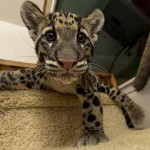

I sat waiting in the dark, searching the various doors on the gigantic FedEx plane for signs that Nicki Boyd, behavior husbandry manager, was about to emerge. Nicki had safely landed in San Diego on this cargo-only flight from Tennessee, bringing very precious cargo from the Nashville Zoo’s clouded leopard breeding program. Suddenly, one of the security guards approached my vehicle, knocked on the window, and said, “Here they come.” Nicki and a FedEx employee carried a large airline crate across the tarmac. Inside were two beautiful clouded leopard brothers, only 14 weeks old. They were hand raised at the Nashville Zoo at Grassmere and were coming to the San Diego Zoo as ambassadors for our Backstage Pass program.
All new animals to our collection must undergo a period of quarantine, necessary to ensure that they not have any infectious disease. So, before the boys could join the gang at Backstage Pass, we had to keep them segregated while our veterinarians cleared them for a variety of infectious agents. Since the boys were young and needed TLC, we decided to quarantine them inside our Neonatal Assisted Care Unit (NACU), known as the nursery by many, facility rather than at our Jennings Center for Zoological Medicine as we usually do.
For the NACU keepers, this was something new and exciting! We hadn’t had a chance to work with clouded leopard cubs since 1990, and these cats had always been a favorite species of ours. We prepared everything in advance: our unit was clean and ready for the boys’ arrival.
The two cubs were surprisingly calm in the transfer crate, curious about their surroundings and greeting me with a shrill chirp. They cried just a few times on the drive to the Zoo but were calm and patient. We carried the crate to the nursery area and opened the crate door. As each cub was released, we weighed him and held him awhile for reassurance, then released him into his new, temporary home. We had constructed a climbing structure for the cubs to play on and placed soft towels, rugs, cat trees, toys, and other enrichment items around the nursery. The cubs sniffed around tentatively at first but were playing with each other and exploring their new climbing structure and toys almost immediately.
NACU keeper Mary Dural prepared their evening diet as directed; she weighed out a portion of raw meat-based zoo carnivore food. Nicki brought some of the meat with her from Nashville, since our zoo does not use the same product. Our Nutritional Services department will change the diet for the cubs, transitioning them from the product they are currently on to our zoo carnivore diet. Since all diet changes are made gradually, we will make the transition slowly, increasing the new diet a little bit on each successive day.
That night each cub ate heartily and drank fresh water. We watched as they played, explored, and attacked each other until they began to tire and flopped themselves down on the floor. It was time to turn out the light and put the cubs to bed. They had arrived safe and sound, but it had been a long day for them.
Janet Hawes is a lead keeper at the San Diego Zoo. Read her previous post, No Babies? What Do Nursery Keepers Do?